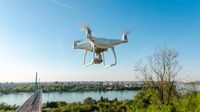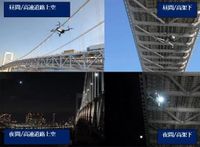In a groundbreaking experiment, the Metropolitan Expressway and five other companies successfully tested the use of drones for nighttime inspections, confirming their effectiveness in a real-world scenario. The verification exercise took place from February 14 to February 15, 2025, at Rainbow Bridge, where the team simulated a nighttime disaster occurrence, showcasing how drone technology can enhance safety and efficiency in urban infrastructure management.
The joint effort included key players such as Metropolitan Expressway, Metropolitan Expressway Technology, JDRONE, Aerocense, KDDI Smart Drone, and NTT Communications. The experiment aimed to evaluate the viability of drone-captured images for infrastructure inspections, specifically examining the accuracy of pre-planned flight paths, as well as the potential for real-time data management through cloud technology. By utilizing GPS systems and real-time monitoring capabilities, the team sought to ensure that the drones could effectively navigate and perform their tasks.
Throughout the duration of the experiment, several critical objectives were pursued. The consortium aimed to validate the practical use of drones in capturing high-quality images, which would be particularly beneficial during disaster scenarios when manual inspections may be risky. It was essential for the team to determine the level of precision achieved between the programmed flight routes and the actual paths taken by the drones.
The findings of the verification project revealed that while some image delays were noted, the overall usefulness of the drones was validated. "Although there were some delays in image transmission, we confirmed the effectiveness of the drone technology for nighttime inspections," stated a representative from the Metropolitan Expressway. This success not only affirms the potential of drone technology in accident prevention and infrastructure maintenance but also sets a precedent for future adoption across various sectors.
With infrastructure safety playing a crucial role in urban environments, the implications of this experiment are significant. The ability to deploy drones for inspections during the night opens up a new dimension in emergency preparedness and response strategies. Cities facing potential disasters can now consider utilizing drones as a reliable alternate method. This could reduce the risk of harm to personnel while ensuring that critical infrastructure is assessed timely.
Furthermore, the experiment highlighted the importance of collaboration among technological firms. With expertise pooled from various organizations, the project capitalized on innovative ideas, leading to advancements in procedures and outcomes. The engagement of firms like KDDI Smart Drone and NTT Communications enriched the experiment, providing not only drone operation capabilities but also data transmission expertise.
Moreover, the project serves as a stepping stone towards future integrations of drone technologies in public safety operations. The metropolitan area planners are already considering how this cutting-edge approach can be incorporated more broadly into their infrastructure strategies, promoting resilience in urban management.
In summary, the verification experiment at the Metropolitan Expressway was a significant step in adopting drones for critical infrastructure inspections, particularly during high-risk times. As cities continue evolving, embracing such technologies may soon become essential for ensuring public safety and infrastructure resilience.


